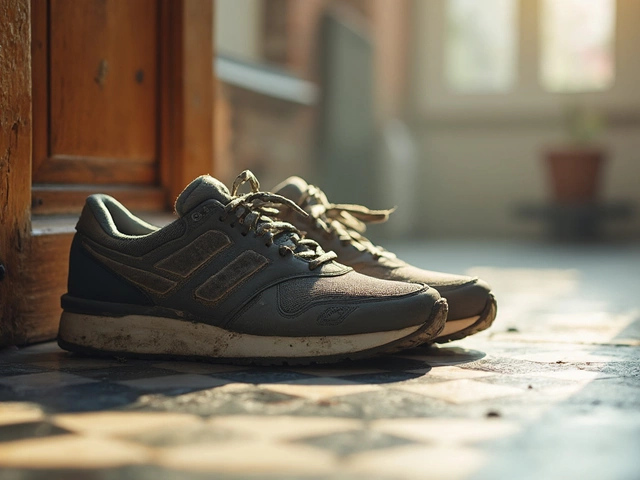Running Shoes: How Do I Know When I Need a New Pair?

You know that feeling when your knees or shins start complaining, but you can’t remember tripping or pushing extra hard? It might not be you—it might be your shoes. Most people wait way too long to swap out their running shoes and end up paying for it with sore feet or cranky joints. Your shoes put in serious work every run, and they’re not built to last forever.
There’s no one-size-fits-all answer for when to ditch a pair, but you can watch for some dead-simple signals. Trust me, your body—and your next run—will thank you for figuring out the right time. Think about checking your shoes just like you check the air in your car tires. Ignoring the warning signs can leave you with more than just a bad workout. You could wind up sidelined by injuries that never needed to happen.
- Weird Aches and Unexplained Pain
- Obvious Signs on the Shoe Itself
- How Many Miles Have You Really Run?
- The Feel Test: Cushion and Support
- Are Your Shoes Failing Before the Miles Are Up?
- Tips to Make Your Running Shoes Last
Weird Aches and Unexplained Pain
If you suddenly start feeling odd pains—maybe in your heels, shins, or even hips—and you haven’t changed how far or how fast you run, it could be your running shoes sending up a red flag. Old shoes lose their bounce and support, and your body picks up the slack. That’s when little aches start to pop up, even if you’re following your normal routine.
One study from the American Academy of Podiatric Sports Medicine found that worn-out midsoles lose shock absorption by up to 40%. That makes every step hit a lot harder, which quickly leads to soreness. Here’s a quick look at where pain often shows up if your shoes are past their prime:
| Pain Location | Possible Cause |
|---|---|
| Knees | Shoe cushioning is worn down, more stress on joints |
| Shins | Arch support or sole shape is shot |
| Feet (heels, arches, toes) | Lack of shock absorption, thin insoles |
We’re not talking about the good-kind of sore after a hard run. This is more like odd twinges, lingering aches, or pain you feel even walking around after. If you keep running in dead shoes, you raise your risk for stress fractures or nasty cases of plantar fasciitis.
- Pain on one side that wasn’t there before? Time to check your shoes.
- If discomfort lingers more than a day or two, don’t push through it—swap out your kicks and see if it improves.
- Always getting sore in the same spot, but only since the last few weeks? That’s classic shoe fatigue territory.
Listening to your body is way smarter (and cheaper) than recovering from an injury. If you notice weird aches, take a hard look at those trainers before blaming your training plan.
Obvious Signs on the Shoe Itself
If you want to know if you're due for a new pair of running shoes, sometimes all you need to do is take a close look. Your shoes can look pretty rough long before they feel terrible. Ignoring what you see is one of the easiest ways to end up with aches or injuries that could have been avoided. Here’s what to check:
- Worn-down outsole: Flip the shoe over and scan for smooth, bald spots where the grippy tread used to be. If an area looks completely flat or the pattern is gone, grip and stability are shot.
- Heel collapse: Press on the back of the shoe. Does it fold inward, or does the heel cup look squished and crooked? That means it’s lost structure and won't support your ankle well anymore.
- Cracked or breaking midsole: Bend the shoe a bit. Notice any deep creases, cracks, or foam that looks compressed? Once that squishy part goes, you lose all the cushioning you paid for.
- Torn upper or blown-out sides: Check the mesh or fabric up top. Holes, tears, or stretched-out spots mean the shoe isn't holding your foot the way it should.
- Liner and inside damage: Peek inside for rips around the heel, holes near your toes, or insole padding that’s worn through. Those spots can rub you raw during a run.
Sometimes shoes break down unevenly—maybe the tread’s gone only on one side, or the foam is cracked but the tops still look okay. Don’t just trust your eyes. Put your foot in, stand up, and see if anything feels off or if your foot tilts oddly.
If you’re the numbers type, here’s how quickly running shoes often wear out depending on usage:
| Weekly Running Distance | Average Shoe Lifespan (months) | Typical Wear Signs First Noticed |
|---|---|---|
| 10-15 miles | 10-12 | Outsole smoothing |
| 15-25 miles | 6-8 | Midsole creases, heel wear |
| 30+ miles | 3-5 | Tears, compressed foam |
If you see any of these signs—and they match your mileage—don’t wait. Swapping out your shoes at the right time saves you from a lot more trouble down the line.
How Many Miles Have You Really Run?
This is where most folks slip up—they have no clue how far they’ve actually run in their shoes. On average, most running shoes are built to last about 300 to 500 miles (roughly 480 to 800 kilometers). Once you hit that range, even if your shoes look fine on the outside, the inside cushioning could be toast.
Take a look at this table to compare shoe replacement mileage for different types of runners and conditions:
| Runner Type | Shoe Replacement Range | Notes |
|---|---|---|
| Lightweight Runner (under 150 lbs) | 400-500 miles | Gets closer to max range |
| Average Runner (150-180 lbs) | 350-450 miles | Mid-range is typical |
| Heavy Runner (over 180 lbs) | 300-400 miles | Lower mileage due to higher impact |
| Rough Surfaces (trail, gravel) | -50 to -100 miles off above | More wear and tear |
If you’ve never tracked your mileage, you’re not alone. The good news? It’s easier than ever with running apps. Most apps let you log every run—and some even let you track miles by shoe. All you’ve got to do is pick your favorite (like Strava or Runkeeper), log your pairs, and let the app do the math. If you run three times a week for about 5 miles each, you’ll rack up 300 miles in about five months. That’s a lot quicker than most people think.
If you run on pavement, hit the gym treadmill, or head out on rocky trails, your shoes age at different rates. Road running is easier on shoes, while trails and gravel chew through them faster. Rotate between two pairs of shoes if you can—it actually makes them both last longer. Mark your calendar or jot down the date when you start a fresh pair so it’s easy to check back without guessing.
The main point: Set up a habit to check your shoe mileage before something starts hurting. Your feet and joints are counting on you to keep track—because your shoes sure won’t tell you when they’re done.

The Feel Test: Cushion and Support
Ever felt like you’re running on concrete—even when you’re on a soft path? That’s a red flag your running shoes have lost their cushion and support. Cushioning doesn’t last forever, even in high-end models. When it goes, your legs and joints catch all the impact. You might not see this, but you’ll feel it.
The average running shoe keeps its cushion for about 300–500 miles, but some runners chew through it faster, especially if they’re heavy-footed or run daily. There’s real data backing this up—a 2018 study in the journal Footwear Science found midsole cushioning in common trainers dropped by more than 40% after just 350 miles.
You don’t have to be a scientist to test your shoes, either. Use this quick feel test in your gear check:
- Press your thumb into the midsole (that’s the squishy part under your heel and forefoot). If it feels hard or barely pushes in, the cushion is likely toast.
- Walk or jog in your shoes on a hard floor. If you feel more jarring or shock than you remember, your shoes aren’t protecting you.
- Look at the insole. If it’s flat or deeply indented in the shape of your foot, support has broken down.
Some shoes seem fine, then fall apart all at once. If you notice aches in your knees or hips that disappear when you wear a new pair, it’s time.
| Miles Run | % Cushion Left | Shoe Feel |
|---|---|---|
| 0 | 100% | Springy, full support |
| 150 | 85% | Slightly less bounce |
| 350 | 60% | Noticeably firmer |
| 500+ | <50% | Lifeless, minimal shock absorption |
If you’re thinking about replacing your shoes but aren’t sure, trust how they feel on your feet more than how they look. That dull, flat feeling means it’s time to retire them. Prioritize comfort and support—your legs will back you up on this one.
Are Your Shoes Failing Before the Miles Are Up?
It’s easy to think your shoes should last until you hit some magical number—like 400 miles or six months. But sometimes shoes start to fall apart long before you reach those stats. Here’s the deal: different shoes wear out at different speeds, and not just from tallying up distance.
Your running style, weight, usual terrain, and even how you store your shoes can speed up wear and tear. For example, if you mostly run on concrete or have a heavy footstrike, your cushioning might wear down way quicker than your marathon neighbor’s shoes. Humidity and heat, or shoving wet shoes into a gym bag, breaks them down even faster.
So how do you know if your running shoes are tapping out early? Look for things like:
- Uneven or flat spots on the midsole where there used to be bounce.
- Noticing your feet and joints feel more beat up after regular runs than they used to.
- The outsole (the bottom part that hits the ground) is worn smooth or totally lost its grip, even if you haven’t hit 300 miles.
- Rips or holes in the mesh, especially near the toe box or where your foot flexes.
- The heel counter (that stiff bit cradling your heel) feels loose or collapsed.
If you usually notice one or more of those signs before you reach the usual mileage, you’re not alone. Sometimes, it’s a quality issue, but most of the time, it’s about how you use and care for your kicks. Keeping track of how your shoes feel, not just the numbers on your watch, is your best bet. If something feels off—even if you haven’t logged tons of miles—it’s probably time for a new pair.
Tips to Make Your Running Shoes Last
Let’s talk about stuff you can actually do to stretch out the life of your running shoes instead of treating them like cheap flip-flops. Some folks burn through a pair in just a couple months, but a little care can keep your investment going strong a lot longer.
If you want your running shoes to give you more miles without falling apart, try these practical tips:
- Rotate Between Pairs: Don’t wear the same pair two days in a row. Muscles need time to recover—and so does shoe foam. Rotating gives cushioning time to bounce back, which actually slows down wear.
- Store Them Right: Skip leaving your shoes in hot cars or damp basements. Both heat and moisture can wreck the glue and break down materials faster than you’d think. Just keep them out in the open, dry and away from heaters.
- Keep Them Clean: Knock off mud and dirt after every run. Washing with mild soap and air drying (never in a dryer) keeps fibers from breaking down. Skip the washing machine—spinning and heat mess with the shape and glue bonds.
- Wear Them Only For Running: Using your running shoes for errands, mowing the lawn, or gym work puts on random, uneven miles. Stick to running in them—you’ll notice the difference.
- Track Your Mileage: Jot down miles on an app or notepad. When you hit the 300-500 mile range, start checking for wear. The table below shows how mileage, surface, and runner weight can change your shoe’s lifespan.
| Mileage | Surface | Runner Weight | Average Shoe Lifespan |
|---|---|---|---|
| 300-400 miles | Road | <150 lbs | 4-6 months |
| 300-500 miles | Trail | 150-180 lbs | 3-5 months |
| 250-350 miles | Mixed (road/trail) | >180 lbs | 2-4 months |
One last tip: always loosen the laces when taking shoes off. Yanking them off by the heel stretches the upper and can split seams—eventually you’ll notice the fit’s never quite right again. Treat your shoes right and they’ll stick with you for the long haul.



